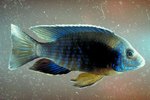
African cichlids, with their bright colors and fascinating behavior, require larger and more stable aquariums than "beginner" aquarium fish. A dedicated cichlid aquarium must meet narrowly specific water requirements to thrive. An intermediate level of aquarium care can sustain an African cichlid aquarium.
Research
Before bringing home African cichlids, do your research. Thousands of species of cichlids live in Africa's rift lakes, and their care varies considerably. Know as much as you can about an African cichlid species before you purchase one. When researching African cichlids, pay special attention to traits like size, temperament and diet. Make sure you understand your African cichlid's care requirements in advance so you will not have problems later.
Water Chemistry
All of the African Rift Valley lakes have similar water chemistry, so all African cichlids have similar requirements. African cichlids require hard, alkaline water with tropical temperatures. This means they need water with pH between 7.5 and 8.5 and temperature between 74 and 80 degrees Fahrenheit. To keep the water hard and the pH high, you can include calcium-rich rocks and substrates like limestone and coral sand, which slowly dissolve and make the water harder. It is crucial to keep the water clean for African cichlids, so keep up on water changes.
Cycling
Fish produce ammonia as a waste product. In aquariums, a process called the ammonia cycle converts ammonia into less-toxic nitrogen compounds. You have to start this process before you get cichlids, since they are particularity sensitive. You can start the ammonia cycle by adding hardy fish to the tank or adding small amounts of pure ammonia to the water. Either way you cycle the tank, you will need test kits for ammonia, nitrite and nitrate to monitor the water. Once the nitrite levels stabilize at zero, you can perform a water change and add your cichlids.
Feeding Time
When feeding your cichlids, feed the right food and avoid overfeeding. Most African cichlids are omnivores. Feed sinking pellets or flakes as a staple food. Give green food like grocery store spinach occasionally, as many cichlids like green foods. Provide the occasional treat of live or frozen animal food like brine shrimp and bloodworms. These are available at most pet shops. Feed only as much as your African cichlids can eat in about 30 seconds. Extra food will rot and pollute the tank.
References
- Tropical Fish Hobbyist: Aquarium Setup Guide
- FishChannel.com; African (Mbuna) Cichlid Aquarium; Paul V. Loiselle
- FishChannel.com; Nitrogen Cycle; David A. Lass
- FishChannel.com; Create a Lake Tanganyika Biotope Aquarium; Rick and Tamela Biro
- MalawiCichlids.com; Fishless Cycling; Chris Cow
- FishChannel.com: Overfeeding Aquarium Fish
Photo Credits
-
Jupiterimages/Photos.com/Getty Images



